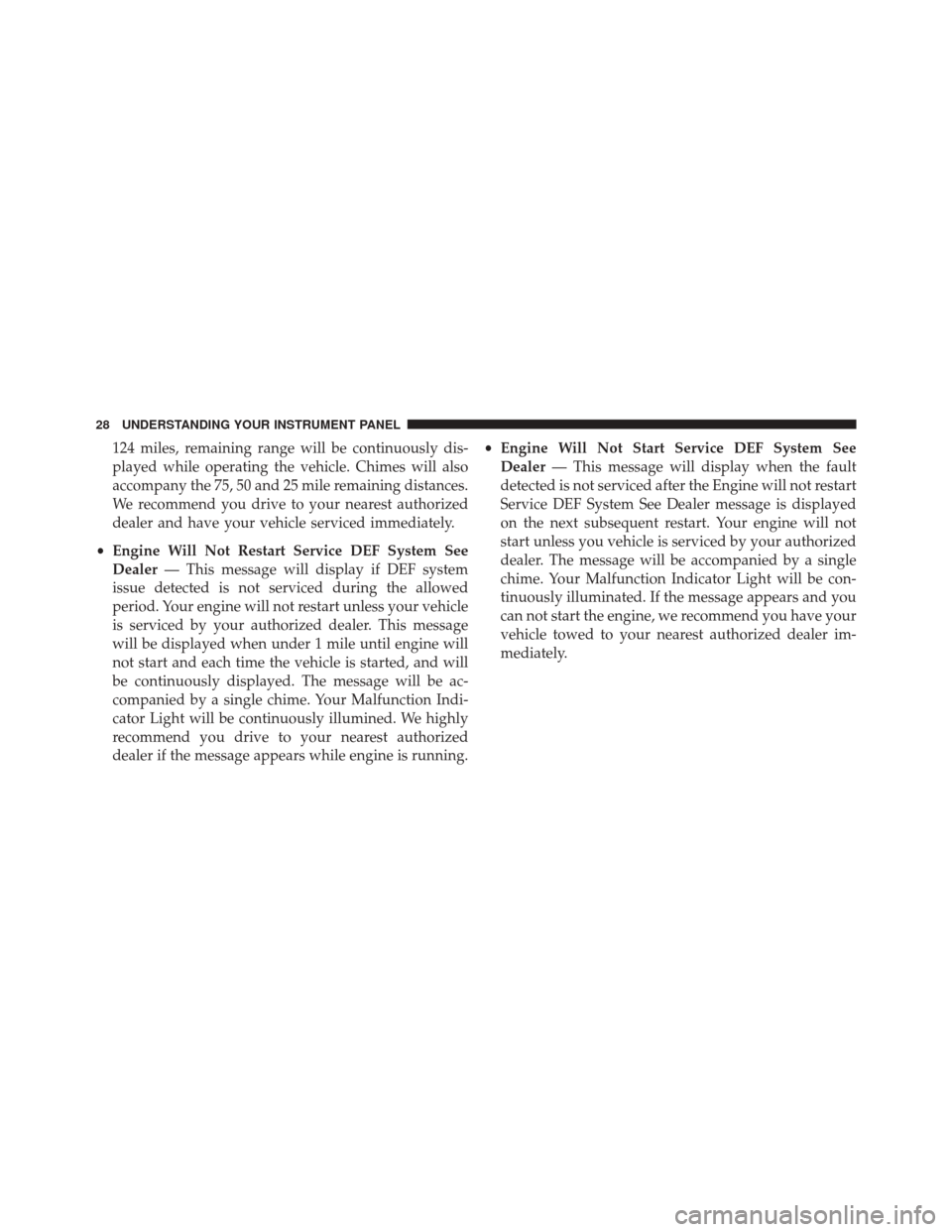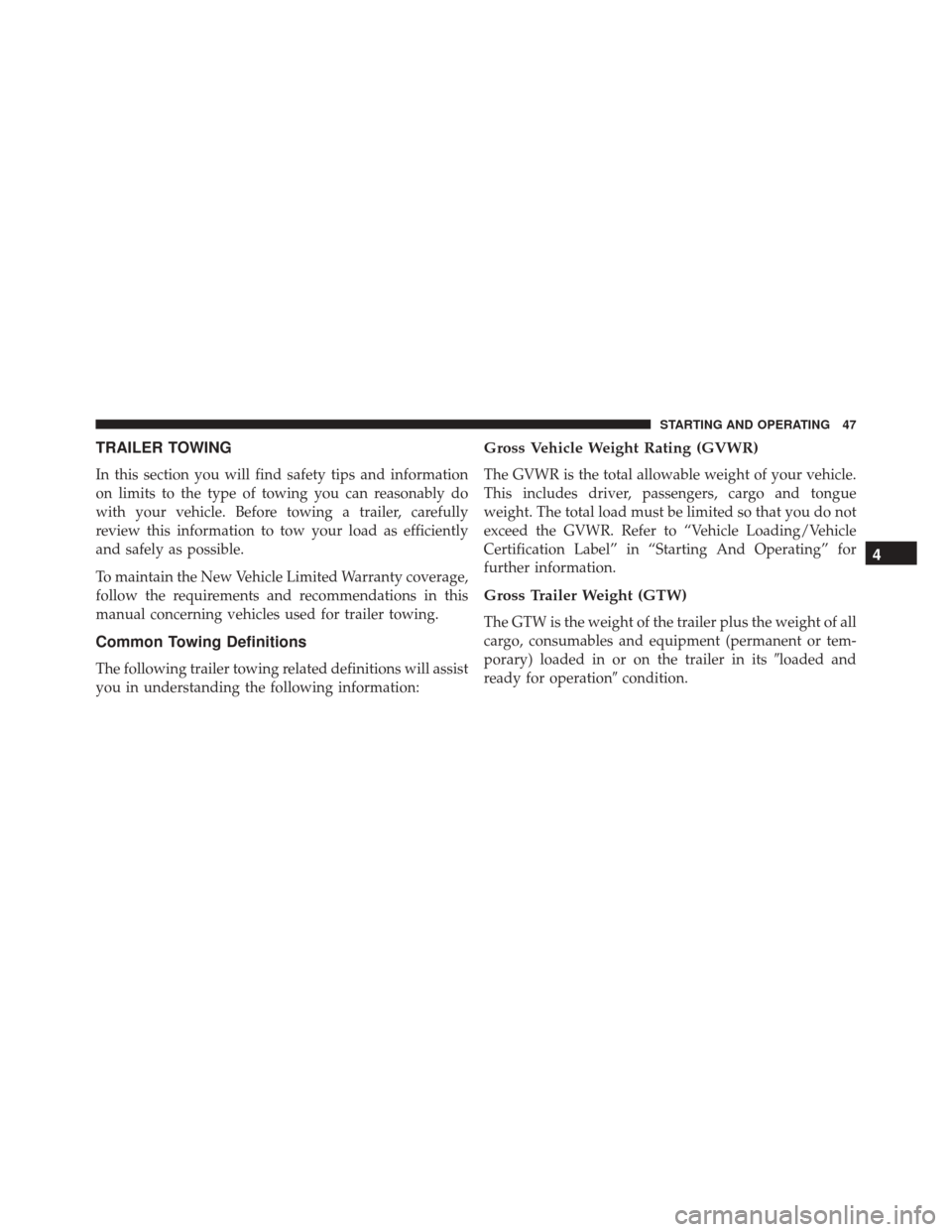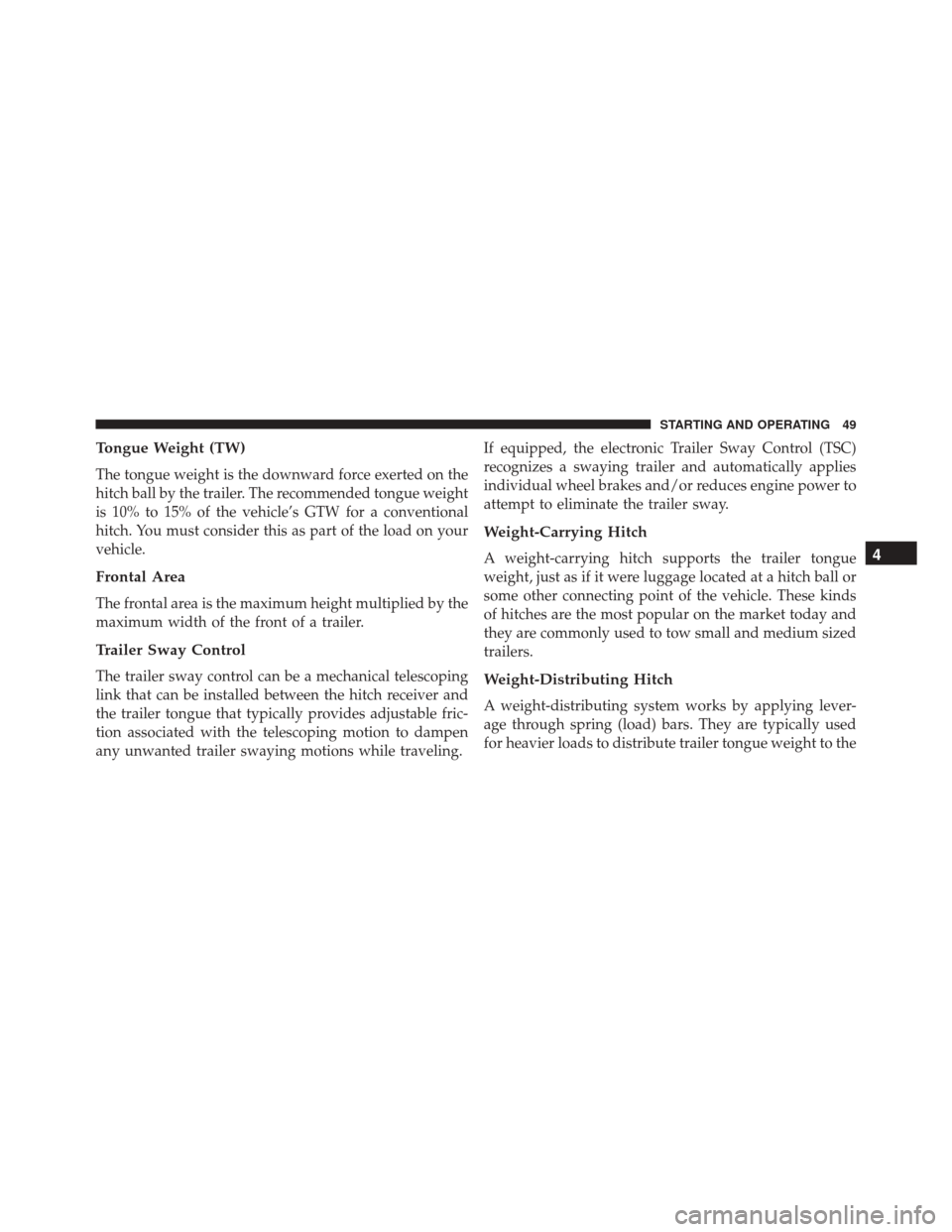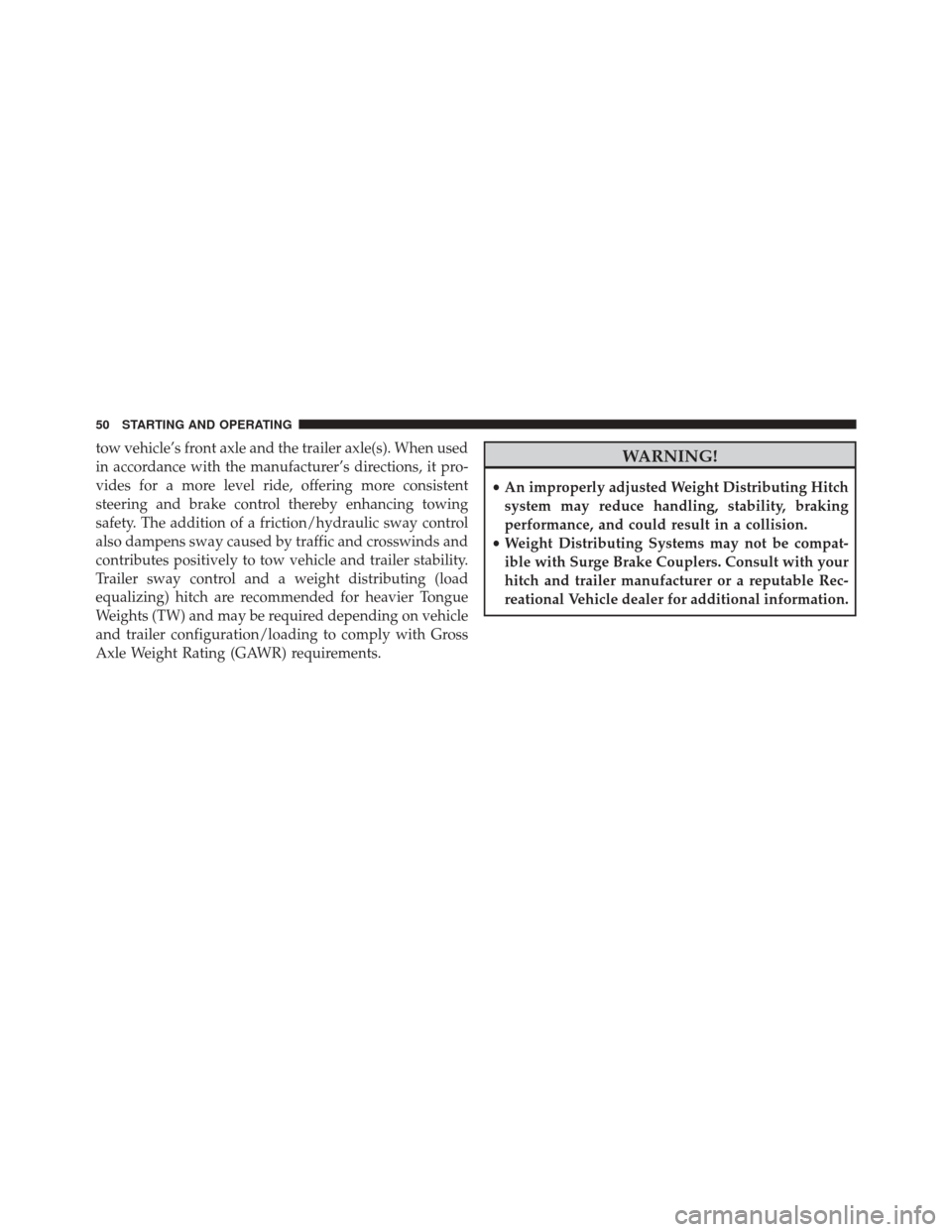Page 11 of 117

•Fuel meets minimum requirement
• System not disabled from previous remote start event
• Vehicle security alarm not active
• Water In Fuel Indicator Light is not illuminated
• “Wait To Start” telltale is not illuminated
WARNING!
•Do not start or run an engine in a closed garage or
confined area. Exhaust gas contains Carbon Mon-
oxide (CO) which is odorless and colorless. Carbon
Monoxide is poisonous and can cause serious in-
jury or death when inhaled.
• Keep Remote Keyless Entry (RKE) transmitters
away from children. Operation of the Remote Start
System, windows, door locks or other controls
could cause serious injury or death.
ENGINE BREAK-IN RECOMMENDATIONS
The diesel engine does not require a break-in period due
to its construction. Normal operation is allowed, provid-
ing the following recommendations are followed:
• Warm up the engine before placing it under load.
• Do not operate the engine at idle for prolonged
periods.
• Use the appropriate transmission gear to prevent
engine lugging.
• Observe vehicle oil pressure and temperature indica-
tors.
• Check the coolant and oil levels frequently.
• Vary throttle position at highway speeds when carry-
ing or towing significant weight.
2
THINGS TO KNOW BEFORE STARTING YOUR VEHICLE 9
Page 12 of 117
NOTE:Light duty operation such as light trailer towing
or no load operation will extend the time before the
engine is at full efficiency. Reduced fuel economy and
power may be seen at this time.
The engine oil installed in the engine at the factory is a
high-quality energy conserving type lubricant. Oil
changes should be consistent with anticipated climate
conditions under which vehicle operations will occur.
The recommended viscosity and quality grades are
shown under “Fluids, Lubricants and Genuine Parts”,
under “Maintaining Your Vehicle” in this manual. NON-
DETERGENT OR STRAIGHT MINERAL OILS MUST
NEVER BE USED.
10 THINGS TO KNOW BEFORE STARTING YOUR VEHICLE
Page 30 of 117

124 miles, remaining range will be continuously dis-
played while operating the vehicle. Chimes will also
accompany the 75, 50 and 25 mile remaining distances.
We recommend you drive to your nearest authorized
dealer and have your vehicle serviced immediately.
• Engine Will Not Restart Service DEF System See
Dealer — This message will display if DEF system
issue detected is not serviced during the allowed
period. Your engine will not restart unless your vehicle
is serviced by your authorized dealer. This message
will be displayed when under 1 mile until engine will
not start and each time the vehicle is started, and will
be continuously displayed. The message will be ac-
companied by a single chime. Your Malfunction Indi-
cator Light will be continuously illumined. We highly
recommend you drive to your nearest authorized
dealer if the message appears while engine is running. •
Engine Will Not Start Service DEF System See
Dealer — This message will display when the fault
detected is not serviced after the Engine will not restart
Service DEF System See Dealer message is displayed
on the next subsequent restart. Your engine will not
start unless you vehicle is serviced by your authorized
dealer. The message will be accompanied by a single
chime. Your Malfunction Indicator Light will be con-
tinuously illuminated. If the message appears and you
can not start the engine, we recommend you have your
vehicle towed to your nearest authorized dealer im-
mediately.
28 UNDERSTANDING YOUR INSTRUMENT PANEL
Page 33 of 117
STARTING AND OPERATING
CONTENTS
�STARTING PROCEDURES .................33
▫ Automatic Transmission .................34
▫ Extreme Cold Weather ...................34
▫ Normal Starting Procedure —
Keyless Enter-N-Go .....................35
▫ Starting Fluids ........................36
� NORMAL OPERATION ...................36
▫ Cold Weather Precautions ................37
▫ Engine Idling .........................39
▫ Stopping The Engine ....................39 ▫
Cooling System Tips — Automatic
Transmission ..........................40
� ENGINE BLOCK HEATER — IF EQUIPPED ....41
� FUEL REQUIREMENTS ...................42
▫ Fuel Specifications .....................43
▫ Biodiesel Fuel Requirements ...............44
� TRAILER TOWING ......................47
▫ Common Towing Definitions ..............47
▫ Trailer Hitch Classification ...............514
Page 34 of 117
▫Trailer Towing Weights (Maximum Trailer
Weight Ratings) .......................52
▫ Trailer And Tongue Weight ...............53
▫ Towing Requirements ...................54
▫ Towing Tips ..........................59
� DIESEL EXHAUST FLUID .................60
▫ System Overview ......................61 �
ADDING FUEL .........................62
▫ Avoid Using Contaminated Fuel ............65
▫ Bulk Fuel Storage — Diesel Fuel ...........65
▫ Diesel Exhaust Fluid Storage ..............65
▫ Adding Diesel Exhaust Fluid ..............66
32 STARTING AND OPERATING
Page 49 of 117

TRAILER TOWING
In this section you will find safety tips and information
on limits to the type of towing you can reasonably do
with your vehicle. Before towing a trailer, carefully
review this information to tow your load as efficiently
and safely as possible.
To maintain the New Vehicle Limited Warranty coverage,
follow the requirements and recommendations in this
manual concerning vehicles used for trailer towing.
Common Towing Definitions
The following trailer towing related definitions will assist
you in understanding the following information:
Gross Vehicle Weight Rating (GVWR)
The GVWR is the total allowable weight of your vehicle.
This includes driver, passengers, cargo and tongue
weight. The total load must be limited so that you do not
exceed the GVWR. Refer to “Vehicle Loading/Vehicle
Certification Label” in “Starting And Operating” for
further information.
Gross Trailer Weight (GTW)
The GTW is the weight of the trailer plus the weight of all
cargo, consumables and equipment (permanent or tem-
porary) loaded in or on the trailer in its�loaded and
ready for operation� condition.
4
STARTING AND OPERATING 47
Page 51 of 117

Tongue Weight (TW)
The tongue weight is the downward force exerted on the
hitch ball by the trailer. The recommended tongue weight
is 10% to 15% of the vehicle’s GTW for a conventional
hitch. You must consider this as part of the load on your
vehicle.
Frontal Area
The frontal area is the maximum height multiplied by the
maximum width of the front of a trailer.
Trailer Sway Control
The trailer sway control can be a mechanical telescoping
link that can be installed between the hitch receiver and
the trailer tongue that typically provides adjustable fric-
tion associated with the telescoping motion to dampen
any unwanted trailer swaying motions while traveling.If equipped, the electronic Trailer Sway Control (TSC)
recognizes a swaying trailer and automatically applies
individual wheel brakes and/or reduces engine power to
attempt to eliminate the trailer sway.
Weight-Carrying Hitch
A weight-carrying hitch supports the trailer tongue
weight, just as if it were luggage located at a hitch ball or
some other connecting point of the vehicle. These kinds
of hitches are the most popular on the market today and
they are commonly used to tow small and medium sized
trailers.
Weight-Distributing Hitch
A weight-distributing system works by applying lever-
age through spring (load) bars. They are typically used
for heavier loads to distribute trailer tongue weight to the
4
STARTING AND OPERATING 49
Page 52 of 117

tow vehicle’s front axle and the trailer axle(s). When used
in accordance with the manufacturer’s directions, it pro-
vides for a more level ride, offering more consistent
steering and brake control thereby enhancing towing
safety. The addition of a friction/hydraulic sway control
also dampens sway caused by traffic and crosswinds and
contributes positively to tow vehicle and trailer stability.
Trailer sway control and a weight distributing (load
equalizing) hitch are recommended for heavier Tongue
Weights (TW) and may be required depending on vehicle
and trailer configuration/loading to comply with Gross
Axle Weight Rating (GAWR) requirements.WARNING!
•An improperly adjusted Weight Distributing Hitch
system may reduce handling, stability, braking
performance, and could result in a collision.
• Weight Distributing Systems may not be compat-
ible with Surge Brake Couplers. Consult with your
hitch and trailer manufacturer or a reputable Rec-
reational Vehicle dealer for additional information.
50 STARTING AND OPERATING